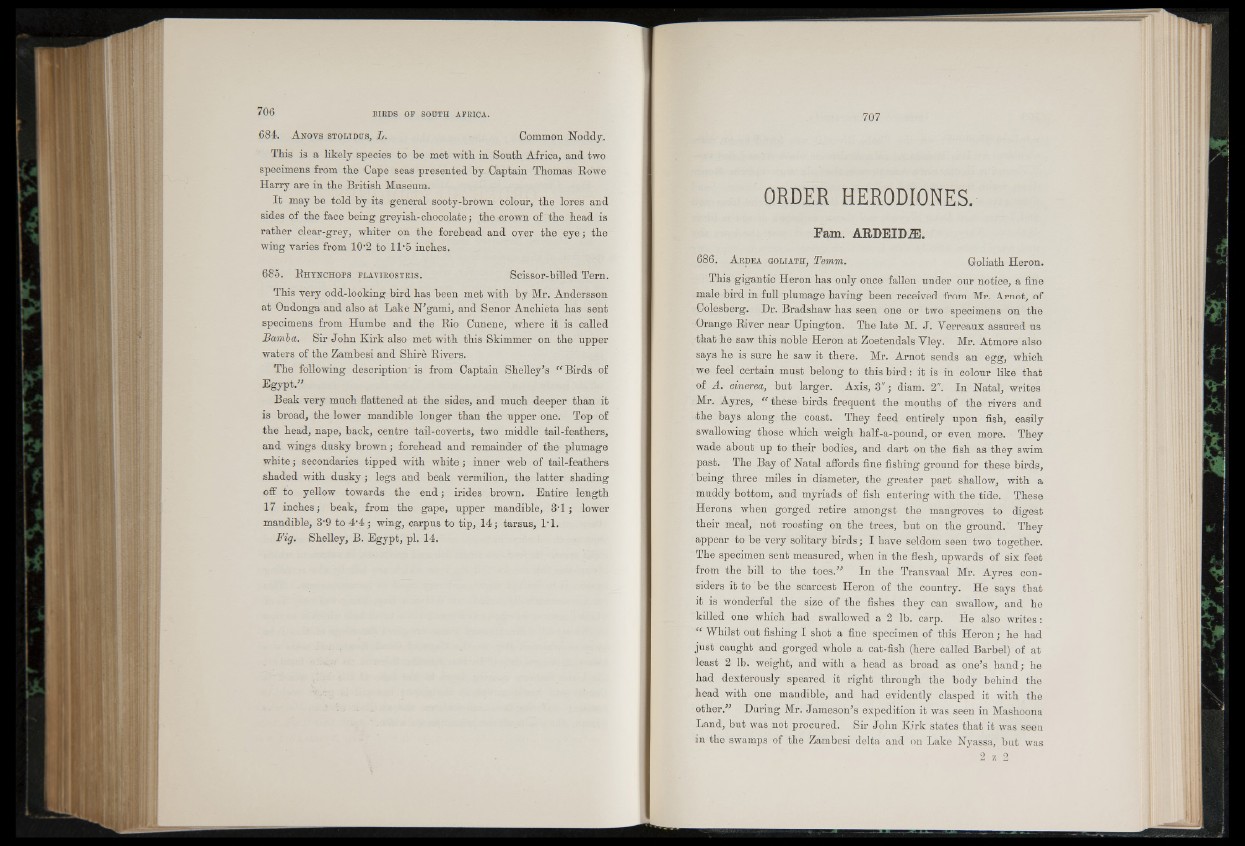
684. A novs stolidus, L. Common Noddy..
This is a likely species to be met with in South Africa, and two
specimens from the Cape seas presented by Captain Thomas Rowe
Harry are in the British Museum.
It may be told by its general sooty-brown colour, the lores and
sides of the face being greyish-chocolate; the crown of the head is
rather clear-grey, whiter on the forehead and over the eye; the
wing varies from 10‘2 to 11*5 inches.
685. R h y n c h o p s fla v ir o str is . Scissor-billed Tern.
This very odd-looking bird has been met with by Mr. Andersson
at Ondonga and also at Lake N’gami, and Senor Anchieta has sent
specimens from Humbe and the Rio Cunene, where it is called
Bamba. Sir John Kirk also met with this Skimmer on the upper
waters of the Zambesi and Shire Rivers.
The following description is from Captain Shelley’s “ Birds of
Egypt.”
Beak very much flattened at the sides, and much deeper than it
is broad, the lower mandible longer than the upper one. Top of
the head, nape, back, centre tail-coverts, two middle tail-feathers,
and wings dusky brown; forehead and remainder of the plumage
white; secondaries tipped with white; inner web of tail-feathers
shaded with dusky; legs and beak vermilion, the latter shading
off to yellow towards the end; irides brown. Entire length
17 inches; beak, from the gape, upper mandible, 3*1; lower
mandible, 3*9 to 4*4; wing, carpus to tip, 14; tarsus, 1*1.
Fig. Shelley, B. Egypt, pi. 14.
ORDER HER0 DI0 NES.
Fam. ARDEIDiE.
686. A rd e a goliath, Temm. Goliath Heron.
This gigantic Heron has only once fallen under our notice, a fine
male bird in full plumage having been received from Mr. Arnot, of
Colesberg. Dr. Bradshaw has seen one or two specimens on the
Orange River near Upington. The late M. J. Verreaux assured us
that he saw this noble Heron at Zoetendals Vley. Mr. Atmore also
says he is sure he saw it there. Mr. Arnot sends an egg, which
w e feel certain must belong to this bird: it is in colour like that
of A. ainerea, but larger. Axis, 3"; diam. 2". In Natal, writes
Mr. Ayres, “ these birds frequent the mouths of the rivers and
the bays along the coast. They feed entirely upon fish, easily
swallowing those which weigh half-a-pound, or even more. They
wade about up to their bodies, and dart on the fish as they swim
past. The Bay of Natal affords fine fishing ground for these birds,
being three miles in diameter, the greater part shallow, with a
muddy bottom, and myriads of fish entering with the tide. These
Herons when gorged retire amongst the mangroves to digest
their meal, not roosting on the trees, but on the ground. They
appear to be very solitary birds; I have seldom seen two together.
The specimen sent measured, when in the flesh, upwards of six feet
from the bill to the toes.” In the Transvaal Mr. Ayres considers
it to be the scarcest Heron of the country. He says that
it is wonderful the size of the fishes they can swallow, and he
killed one which had swallowed a 2 lb. carp. He also writes:
“ Whilst out fishing I shot a fine specimen of this Heron; he had
just caught and gorged whole a cat-fish (here called Barbel) of at
least 2 lb. weight, and with a head as broad as one’s hand; he
had dexterously speared it right through the body behind the
head with one mandible, and had evidently clasped it with the
other.” During Mr. Jameson’s expedition it was seen in Mashoona
Land, but was not procured. Sir John Kirk states that it was seen
in the swamps of the Zambesi delta and on Lake Nyassa, but was
2 7. 2